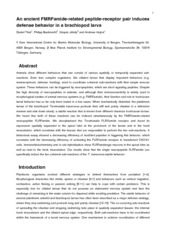| dc.description.abstract | Animals show different behaviors that can consist of various spatially or temporally separated sub-reactions. Even less complex organisms, like ciliated larvae that display important behaviors (e.g. metamorphosis, defense, feeding), need to coordinate coherent sub-reactions with their simple nervous system. These behaviors can be triggered by neuropeptides, which are short signaling peptides. Despite the high diversity of neuropeptides in animals, and although their immunoreactivity is widely used in morphological studies of animal nervous systems (e.g. FMRFamide), their function and role in trochozoan larval behavior has so far only been tested in a few cases. When mechanically disturbed, the planktonic larvae of the brachiopod Terebratalia transversa protrude their stiff and pointy chaetae in a defensive manner and sink down slowly: a startle reaction that is known from different chaetous trochozoan larvae. We found that both of these reactions can be induced simultaneously by the FMRFamide-related neuropeptide FLRFamide. We deorphanized the Terebratalia FLRFamide receptor and found its expression spatially separated in the apical lobe at the prototroch of the larvae and in the trunk musculature, which correlates with the tissues that are responsible to perform the two sub-reactions. A behavioral assay showed a decreasing efficiency of modified peptides in triggering this behavior, which correlates with the decreasing efficiency of activating the FLRFamide receptor in transfected CHO-K1 cells. Immunohistochemistry and in situ hybridization show FLRFamidergic neurons in the apical lobe as well as next to the trunk musculature. Our results show that the single neuropeptide FLRFamide can specifically induce the two coherent sub-reactions of the T. transversa startle behavior. | en_US |

